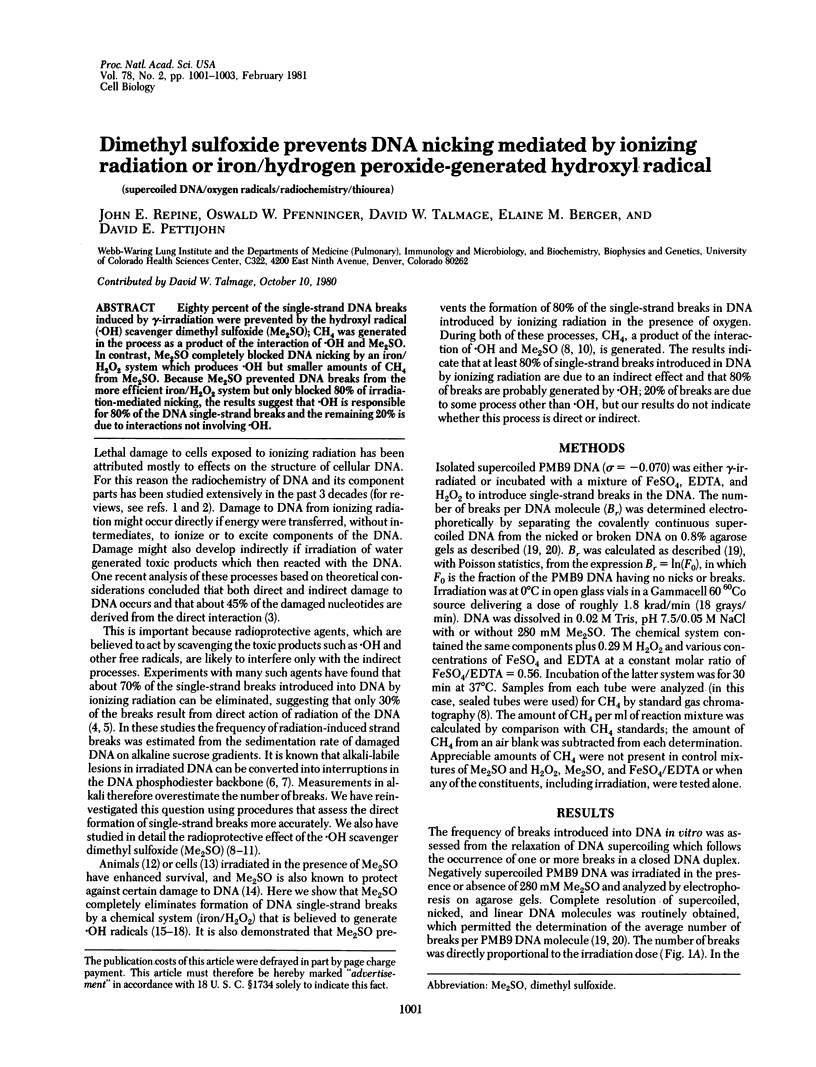Abstract
Eighty percent of the single-strand DNA breaks induced by gamma-irradiation were prevented by the hydroxyl radical (.OH) scavenger dimethyl sulfoxide (Me2SO); CH4 was generated in the process as a product of the interaction of .OH and Me2SO. In contrast, Me2SO completely blocked DNA nicking by an iron/H2O2 system which produces .OH but smaller amounts of CH4 from Me2SO. Because Me2SO prevented DNA breaks from the more efficient iron/H2O2 system but only blocked 80% of irradiation-mediated nicking, the results suggest that .OH is responsible for 80% of the DNA single-strand breaks and the remaining 20% is due to interactions not involving .OH.
Full text
PDF


Selected References
These references are in PubMed. This may not be the complete list of references from this article.
- ASHWOOD-SMITH M. J. The radioprotective action of dimethyl sulphoxide and various other sulphoxides. Int J Radiat Biol Relat Stud Phys Chem Med. 1961 Jan;3:41–48. doi: 10.1080/09553006114550051. [DOI] [PubMed] [Google Scholar]
- Achey P. M., Billen D., Beltranena H. P. Single-strand breaks in gamma-irradiated phi-X174 DNA induced by exposure to alkali. Int J Radiat Biol Relat Stud Phys Chem Med. 1971;20(5):501–504. doi: 10.1080/09553007114551411. [DOI] [PubMed] [Google Scholar]
- BRIDGES B. A. Protection of Pseudomonas sp. against gamma-radiation by dimethyl sulphoxide. Int J Radiat Biol Relat Stud Phys Chem Med. 1962 Apr;5:101–104. doi: 10.1080/09553006214550611. [DOI] [PubMed] [Google Scholar]
- Blok J., Loman H. The effects of gamma-radiation in DNA. Curr Top Radiat Res Q. 1973 Dec;9(2):165–245. [PubMed] [Google Scholar]
- Chapman J. D., Reuvers A. P., Borsa J., Greenstock C. L. Chemical radioprotection and radiosensitization of mammalian cells growing in vitro. Radiat Res. 1973 Nov;56(2):291–306. [PubMed] [Google Scholar]
- Cohen G., Cederbaum A. I. Chemical evidence for production of hydroxyl radicals during microsomal electron transfer. Science. 1979 Apr 6;204(4388):66–68. doi: 10.1126/science.432627. [DOI] [PubMed] [Google Scholar]
- Cohen G. The generation of hydroxyl radicals in biologic systems: toxicological aspects. Photochem Photobiol. 1978 Oct-Nov;28(4-5):669–675. doi: 10.1111/j.1751-1097.1978.tb06993.x. [DOI] [PubMed] [Google Scholar]
- Fridovich I. The biology of oxygen radicals. Science. 1978 Sep 8;201(4359):875–880. doi: 10.1126/science.210504. [DOI] [PubMed] [Google Scholar]
- Keller W. Determination of the number of superhelical turns in simian virus 40 DNA by gel electrophoresis. Proc Natl Acad Sci U S A. 1975 Dec;72(12):4876–4880. doi: 10.1073/pnas.72.12.4876. [DOI] [PMC free article] [PubMed] [Google Scholar]
- Klein S. M., Cohen G., Cederbaum A. I. The interaction of hydroxyl radicals with dimethylsulfoxide produces formaldehyde. FEBS Lett. 1980 Jul 28;116(2):220–222. doi: 10.1016/0014-5793(80)80648-x. [DOI] [PubMed] [Google Scholar]
- McCord J. M., Day E. D., Jr Superoxide-dependent production of hydroxyl radical catalyzed by iron-EDTA complex. FEBS Lett. 1978 Feb 1;86(1):139–142. doi: 10.1016/0014-5793(78)80116-1. [DOI] [PubMed] [Google Scholar]
- Michaels H. B., Hunt J. W. A model for radiation damage in cells by direct effect and by indirect effect: a radiation chemistry approach. Radiat Res. 1978 Apr;74(1):23–34. [PubMed] [Google Scholar]
- Paterson M. C., Roozen K. J., Setlow R. B. -Ray-induced chain breaks and alkali-labile bonds in lambda d upsilon DNA of Escherichia coli minicells irradiated under aerobic and anoxic conditions. Int J Radiat Biol Relat Stud Phys Chem Med. 1973 May;23(5):495–508. doi: 10.1080/09553007314550571. [DOI] [PubMed] [Google Scholar]
- Pettijohn D. E., Pfenninger O. Supercoils in prokaryotic DNA restrained in vivo. Proc Natl Acad Sci U S A. 1980 Mar;77(3):1331–1335. doi: 10.1073/pnas.77.3.1331. [DOI] [PMC free article] [PubMed] [Google Scholar]
- Repine J. E., Eaton J. W., Anders M. W., Hoidal J. R., Fox R. B. Generation of hydroxyl radical by enzymes, chemicals, and human phagocytes in vitro. Detection with the anti-inflammatory agent, dimethyl sulfoxide. J Clin Invest. 1979 Dec;64(6):1642–1651. doi: 10.1172/JCI109626. [DOI] [PMC free article] [PubMed] [Google Scholar]
- Roots R., Okada S. Protection of DNA molecules of cultured mammalian cells from radiation-induced single-strand scissions by various alcohols and SH compounds. Int J Radiat Biol Relat Stud Phys Chem Med. 1972 Apr;21(4):329–342. doi: 10.1080/09553007214550401. [DOI] [PubMed] [Google Scholar]


